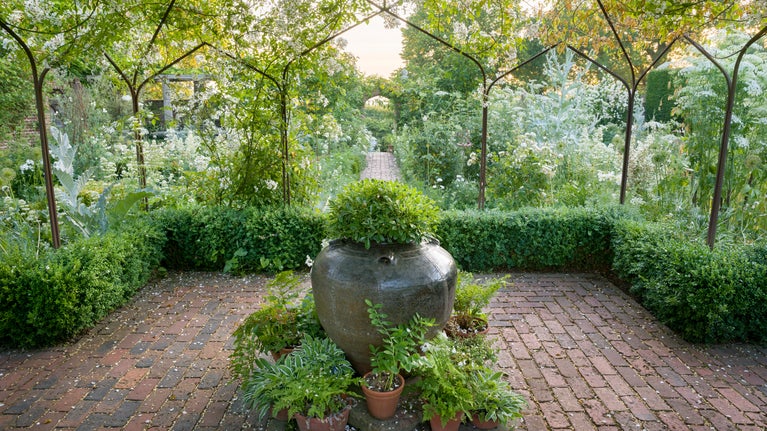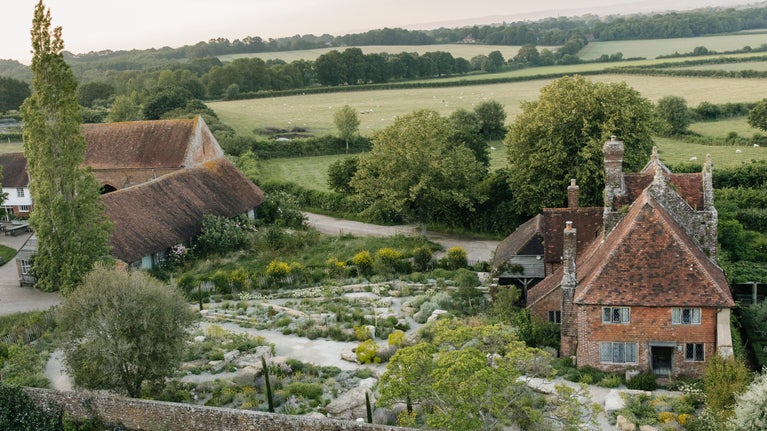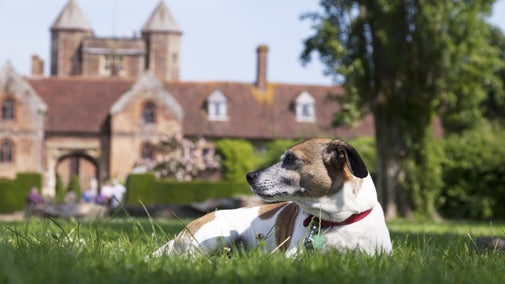The garden at Sissinghurst Castle Garden

Discover why Sissinghurst is famous as the epitome of the English garden and explore its series of garden rooms, each filled with different planting schemes and unique designs. Heralded for its beauty and diversity, the garden is a result of the creative tension between Harold Nicolson's formal design and the exuberant planting of Vita Sackville-West.
Your visit to the garden
What to look out for this spring
Spring highlights in the garden
At Sissinghurst the first signs of spring usually start to reveal themselves in February although, strictly speaking, the snowdrops and bright yellow winter aconites that start to emerge outside South Cottage, are really winter flowers. Nevertheless, these small, defiant signs of life that begin as a trickle mark the beginning of what will become the torrent of spring.
Soon we see the fat pink shoots of Paeonia Mlokosewitschii (golden peony) pushing up through the dark earth followed by hellebores and the jewel-like witch hazels. Even Crocus thomasinianus, which has generally disgraced itself at Sissinghurst by spreading with far too much vigour and disregard for its neighbours, is a welcome relief from the greyness of winter that enfolds the garden in February. The sheet of pure intense violet that covers the beds of the Lime Walk is colour therapy of the best kind.
By early March the Orchard finally starts to reveal some of the many daffodils that grow there. The early Narcissus 'February Gold' is followed by our native daffodil, Narcissus pseudonarcissus, and then in a rush the others follow. The orchard really is lovely in spring and by the middle of March many of the daffodils should be getting into their stride.
The Lime Walk
Harold planned the Lime Walk to look its best during March, April and May. Since his death in 1968, successive Head Gardeners have ensured that the beauty and simplicity of the Lime Walk endures, continuously improving and replanting areas that need attention. Many of Harold’s choices are still used today and we hope that if Harold were to see the Lime Walk, he would approve of how we care for his legacy. It is a wonderful sight in April and a joyful reminder that winter has finally passed.
Blossoms at Sissinghurst
One of the more popular blossoms in the garden is the magnolia. With lots of different varieties that flower at different times it makes for an impressive sight during spring. There’s Magnolia denudata in the Lower Courtyard which is the first to flower, usually in April, with huge white flowers. Also in the same bed is Magnolia liliflora ‘Nigra’, flowering slightly later but with dark pink flowers, and a Magnolia kobus x stellata.
There’s also Magnolia kobus in the Cottage Garden and some new magnolias in the Top Courtyard. One is called Magnolia ‘Scented Gem’. Apparently this cultivar came from the seed of a Magnolia denudata that was growing in a temple in Korea. And two magnolias in the White Garden called Magnolia x soulangeana ‘Rustic Rubra’ tend to flower throughout spring.
For a truer sense of blossom the orchard is the place to visit. There are lots of old apple trees, many of which are unidentified, but they all have vibrant blossom nonetheless.
Our garden team recommend the Malus hupehensis, or crab-apple blossom. This is a large specimen nestled within the orchard, which always has an abundance of frothy white blossom.
Later into spring, the orchard with its 1,100 fruit trees present a canopy of blossom that makes for spectacular images from April. The cherry blossom trees toward the east end of the orchard are, quite rightly, a must-see for many of you.
The Purple Border
In spring, the first wave of purple arrives with the tulips, wallflowers, Lunaria annua (honesty) and Hesperis matronalis (sweet rocket) that weave their way through the clumps of emerging foliage. The silvery Cynara cardunculus (cardoon) leaves are always quick to emerge and make a great foil to the purples and mauves.
More 'rooms' to look out for
Beyond the most famous areas, there are many more spaces and features to discover in the garden at Sissinghurst
The White Garden
Wander through the White Garden for a refreshing contrast to the more colourful parts of the garden. Vita decided that only the colours of white, green, grey and silver were to be allowed to grow in this garden and it's now one of the most famous areas at Sissinghurst.
The origins
Vita understood that when colour is restricted, the gardener has to focus on creating interest and drama with different shapes, textures and form.
When planning the garden, Harold found some white gladioli, white irises, white pompom dahlias and the white Japanese anemones, which he and Vita both loved. Look out for evidence of his all-important structure here, too – yew and box hedging allow the white flowers and silver foliage to shine out against the dark background.
Documenting the garden's creation
In her plans, Vita imagined ‘a low sea of grey clumps of foliage, pierced here and there with tall white flowers’ and by 1953 she was able to report to her Observer readers how this vision was progressing.
She writes about various grey mounds: artemisia, the silver Cineraria maritima, grey santolina and Achillea ageratifolia. These are pierced with the upright white trumpets of Lilium regale and the white spires of eremurus, foxgloves and delphiniums.
There are shrubs to add volume and structure; Hydrangea grandiflora, a white cistus, Paeonia suffruticosa subsp. Rockii and Buddleia nivea as well as trees such as Hippophae rhamnoides, a Pyrus salicifolia ‘Pendula’ and almond trees lining the central path. The giant Arabian thistle Onopordon arabicum surges up 8 feet into the air, whilst foamy gypsophila softens the planting.
Today, the garden team strives to maintain the White Garden in this way using a mixture of shrubs, roses, perennials and annuals to create interest and drama.
A worthwhile challenge
It was the contrast of all these plants together that created interest for the eye, despite the absence of colour. Vita seemed to relish the challenge, writing:

It is something more than merely interesting. It is great fun and endlessly amusing as an experiment, capable of perennial improvement, as you take away the things that don’t fit in, or that don’t satisfy you, and replace them by something you like better

Delos
Experience a taste of island life as you walk through Delos, the area of the garden named after the Greek island and inspired by Vita and Harold's visits there.
The couple had wanted to emulate the feel of the island both in planting and with a ruined feel but, unfortunately, the Kent climate and the garden's north-facing position proved problematic. This, combined with their limited knowledge of Mediterranean planting, meant that it never really became all they hoped it would be.
A must-see in the garden
Regional Curator Dr Jerzy J Kierkuc-Bielinski highlights a feature of Delos that you shouldn't miss:
'The garden rooms at Sissinghurst contain a number of objects that evoke the worlds of ancient Rome or of ancient Greece. Amongst these, I think that the group of Hellenistic altars from the sacred island of Delos are the most intriguing. What ancient rites or sacrifices were performed at these altars?
'Harold Nicolson’s ancestor Captain Hamilton fought in the Greek War of Independence during the 1820s. It was he who brought the altars from Delos to Shanganagh Castle in Ireland. From there they would eventually be brought to Sissinghurst by Harold.'
Would you like to know more about our team's priorities when you visit? Our Gardeners' Cuttings are monthly updates written by the garden team that can be picked up at the garden entrance or read online.
You might also be interested in

Visiting Sissinghurst Castle Garden with your dog
Sissinghurst Castle Garden is a one pawprint rated place. Dogs are welcome so you can feel at ease when strolling through the estate. Here's some useful information to help you enjoy your walk.
Reimagining Delos at Sissinghurst Castle Garden
Find out more about the final phase in developing the Delos garden at Sissinghurst Castle, reimagined from Vita and Harold’s original vision.

Gardening tips
Discover our gardeners’ top tips so you can make the most of your garden, plot or window box.

Gardens in Kent
There are spring gardens aplenty to explore in Kent, including Sissinghurst – one of the most famous in the country. From productive walled gardens to beautiful blooming borders, there's something for every taste and a range of events to match.





